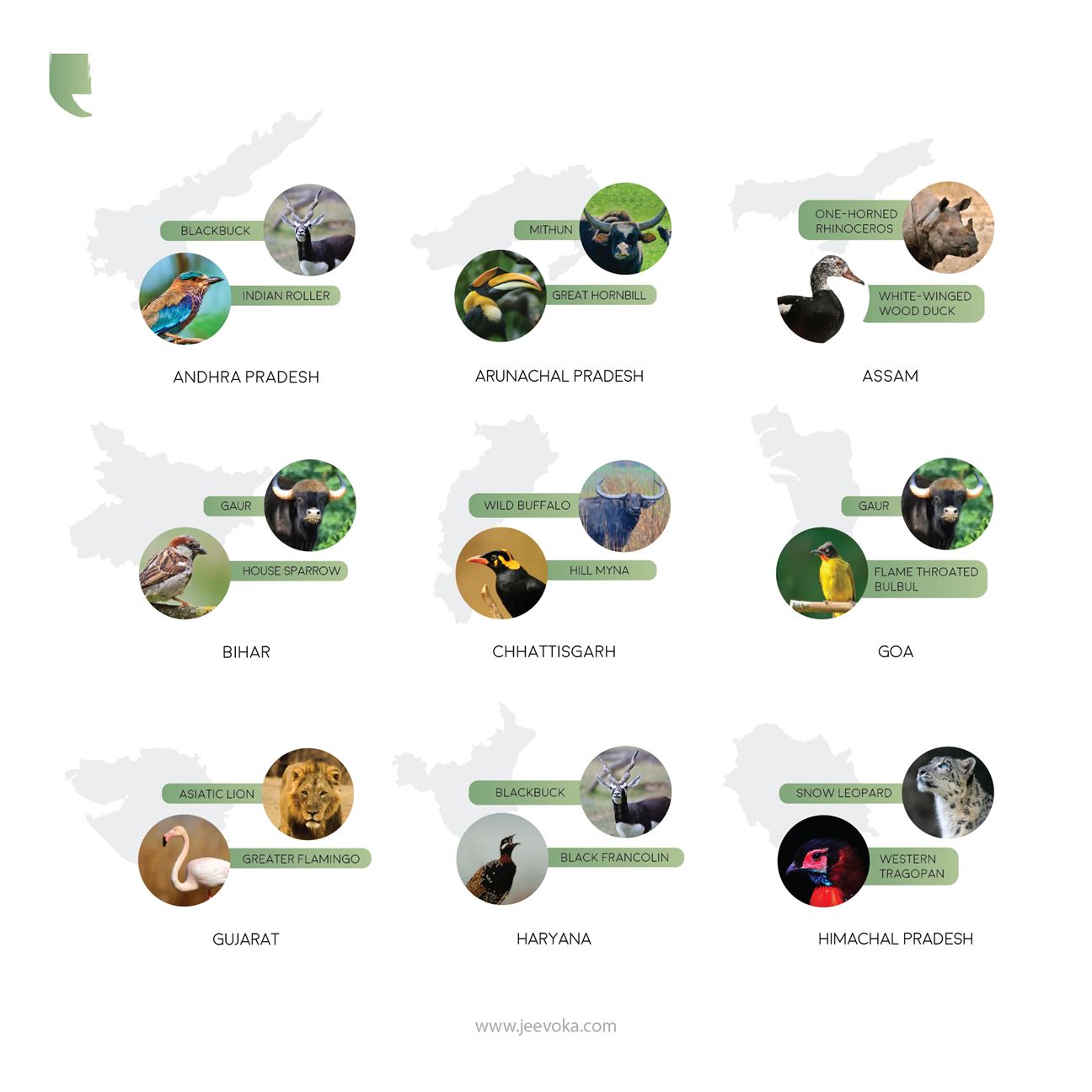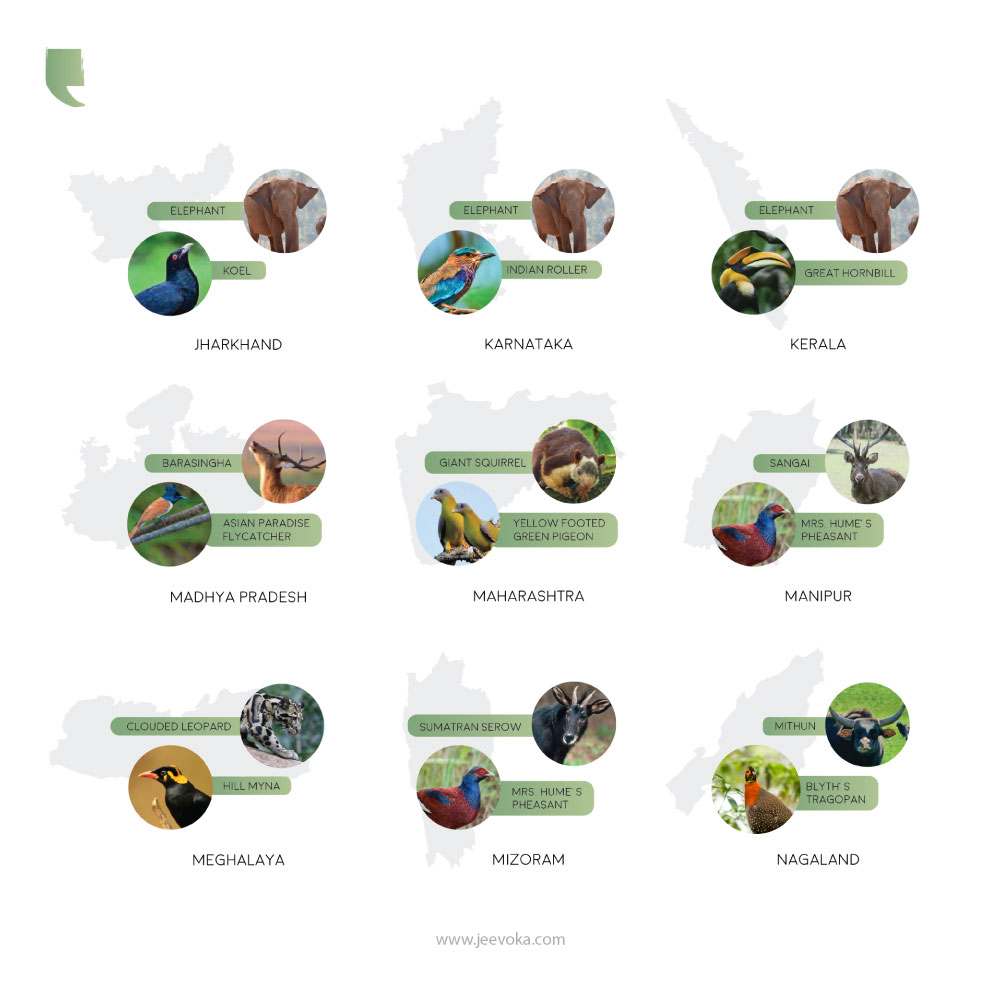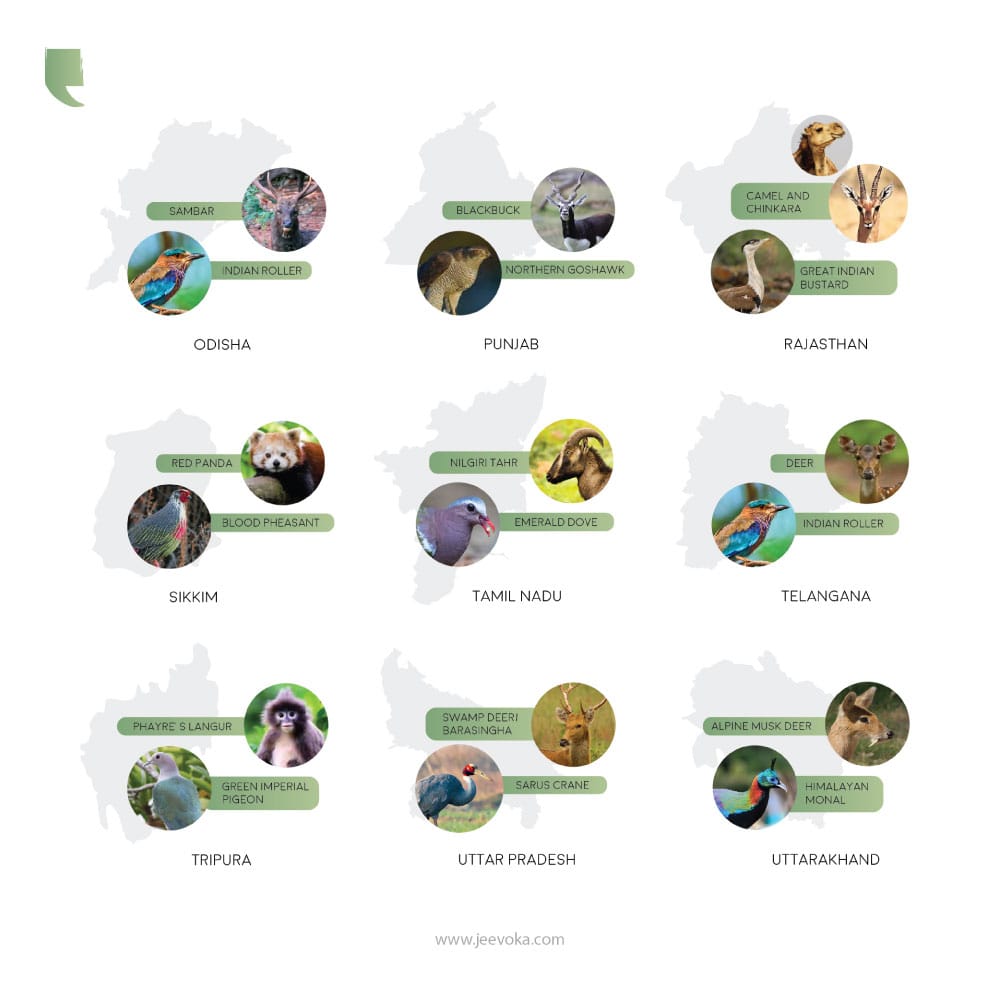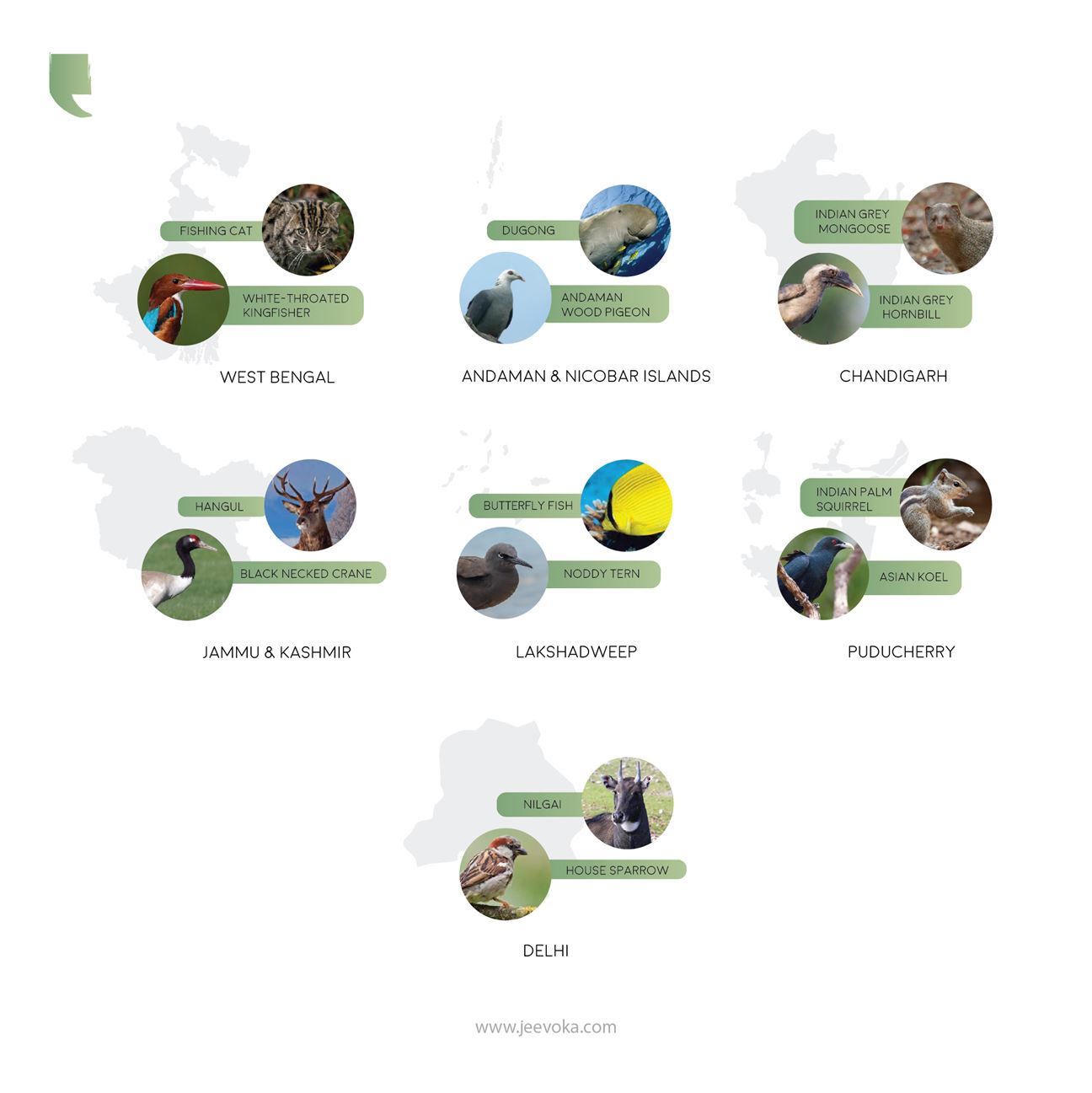In India, did you know that each state has its own allotted bird and animal? Here's all you need to know!
We all know that the national animal of India is the Tiger and the national bird is the Indian peacock. However, did you know that each state has been designated a different state animal and bird? These decisions are taken based on different reasons. Some are important in the state's culture, some because the animals/birds are endemic to the region, and some because the state provides a suitable habitat. The important thing is that most of them are unknown and neglected. Let's take a good look at ALL the states and union territories of India!
Andhra Pradesh
State Bird – Indian Roller
The brightly coloured bird is characterised by a greyish olive coloured back, brownish breast and different shades of blue on its crown, wings, tails and belly. These birds usually lead a solitary life but can be seen in flocks to feed on swarms of insects. They feed on insects, small snakes, frogs, and other amphibians. During the breeding season, males attract females with an aerobatic display with some stunning turns and twists, which gave them their name ‘Rollers’.
State Animal – Blackbuck
Male Blackbucks can be identified by their long spiralling horns, which can grow more than 20 inches. The females don’t have horns and have a different colour of fawn to tan. Males have a dark brown to black upper parts, and both have the distinct white underparts and legs. Both males and females have white patches around their eyes, mouth, and rump.
Arunachal Pradesh
State Bird – Great Hornbill
The large hornbill can be identified by its large white and yellow bill, the yellow casque, and the black and white body. Males are larger than females. These are large birds with a wingspan up to 5 feet and are the largest hornbill species found in India. Even though they look heavy, they’re actually very light because of their thin-walled hollow cells.
State Animal – Mithun
This stocky bovine species is also known as ‘Cattle of Mountain’ or Gayal. These animals are brown or black with yellowish or white limbs, unique flat and triangular forehead, and thick blackish horns. The females are much smaller than the bulls. Gayals are said to be a hybrid of the wild gaur and domestic cattle.
Assam
State Bird – White-winged wood duck
The duck can be identified by its black body, white head with black spots, red or orange eyes, and white patches on its wings. Both male and female look very similar, but males have a glossier plumage and might be larger than the female. It mostly prefers hidden swampy areas in dense forests. It is active at dusk and dawn, feeding on aquatic plants, frogs, fishes, and snakes. Unfortunately, it is one of the most endangered birds in the world with only 800 birds thriving in the world.
State Animal – One-horned rhinoceros
The One-Horned Rhino, also known as the Indian Rhino, is the largest species of Rhinoceros. It can be easily identified by its single black horn, which can grow up to 8–25 inches long. It has a grey-brown body which looks like an armour look due to its skin folds. It mostly leads a solitary life and can be seen grazing on grass, aquatic plants, and shrubs; in the grasslands of North-eastern India. The species was very close to extinction, but the right and successful efforts have resulted in their population increase.
Bihar
State Bird – House Sparrow
House sparrows are the chirpy birds that find solace in and around human settlements. They’re only around 15-cm long with a grey and brown-coloured body. Even with such a small size, they have the ability to fly at a speed of 38–50 km/hr. Males can be identified by their darker brown back and black patch on its throat. Once found abundant, their numbers have gone down fast.
State Animal – Gaur
Also known as the Indian Bison, Gaur is the largest species among wild cattle. It has a huge built, dark brown body, pale-coloured muzzle, tan or white legs, large ears, and horns growing from the side of its head. Both males and female have these upward curving horns.

Chhattisgarh
State Bird – Hill Myna
Hill mynas have a characteristic glossy black body, yellow head and nape wattles, orange bill, yellow legs, and white patches on their wings. Both males and females look alike, with juveniles having a duller beak. These birds are found flying in pairs or in small flocks, in humid forests and forest edges.
State Animal – Wild buffalo
This large buffalo is native to India and Southeast Asia. It has a greyish-black body with coarse hair, narrow head, small ears, upward curving horns, and a tuft on its forehead. It is bulkier than the common buffalo. Males and females look alike. It is found around swamps and wet grasslands. Unfortunately, it has been listed as Endangered because of the sudden decline in its population.
Goa
State Bird – Flame throated bulbul
The flame-throated bulbul has a yellow body with a black head and bright orange throat. It is native to south India and prefers rocky hills, but can also be seen in the Western Ghats. It is often seen moving in flocks, happily singing with mellow sounds.
State Animal - Gaur
Gaurs are found in the range of evergreen forests to deciduous forests. These bovids love the hilly regions and can be seen foraging on bamboo, shrubs, and grass. Studies have shown that these animals have become nocturnal to deal with extreme human intervention. They roam around in small herds which are led by an old female.
Gujarat
State Bird – Greater Flamingo
These large pink birds are renowned for their beauty. They prefer saline lakes where the water is shallow. Flamingoes clear up the muddy water with their webbed feet; and their long but curved neck and bent beaks help them feed on small fish, planktons, or larvae. A crustacean, brine shrimp, actually brings out the pink colour in them. They live and breed in large colonies; while taking care of their grey and white chicks.
State Animal – Asiatic Lion
These huge cats can now be found only in the forests of Gir, Gujarat. Living in prides, these majestic cats prey on Chittal deer, other herbivores, and even cattle. Asiatic lions are smaller than their brothers, African lions. Apart from habitat loss, inbreeding is a huge problem because of the limited population and area.
Haryana
State Bird – Black francolin
Black francolin belongs to the pheasant family. The male has a black-coloured body, rufous belly, white eyepatch, and golden brown spots on the back. The female is smaller, streaked, brown with an orange nape, and a whitish throat. It is usually seen alone or in pairs and is mostly heard than seen. It prefers a habitat of weedy fields and dry grasslands.
State Animal – Blackbuck
They are the only extant member of the genus Antilope. These are the fastest land animals in India and rely on their good eyesight to stay away from danger.
Himachal Pradesh
State Bird – Western Tragopan
The short-tailed pheasant male can be identified by its dark body with white spots, blue throat, red neck and face bordered by a black crown and ears. The female has a brownish-grey body spotted with black and white dots and streaks. The birds feed on the ground but nest on the trees of dense coniferous forests. These are the rarest of all living pheasants.
State Animal – Snow leopard
The snow leopard is a well-adapted animal. Its white-grey coat blends in with its habitat of rocky mountains of Asia, powerful build to tackle the steep slopes, structured hind legs to aid in leaping to a great distance, and a long tail for balance. The majestic big cat has been listed as ‘Vulnerable’ due to extreme habitat loss and poaching.
Jharkhand
State Bird – Koel
The males have a glossy bluish-black body, bright red eyes, and pale beak and legs. Females are brownish with white streaks and spots. They’re known for their specific call and are also a part of the Indian poetry world. These are found in woodlands and fields foraging on insects, vertebrates, and eggs. They’re brood parasites, hence lay their egg in nests of other birds.
State Animal - Elephant
Elephants are seen in a wide range of habitats like grasslands and forests. They’re very social and are seen in groups led by the oldest female. The largest animals on land, elephants, are also known for their intelligence and emotions.
Karnataka
State Bird – Indian Roller
These colourful birds are widely found in India. Locally, they’re known as ‘Neelkanth’ which means ‘blue throat’. The name is associated with the deity Shiva who is said to have drunk poison causing his throat to turn blue. They’re mostly found in urban & suburban areas, and near open grounds.
State Animal – Elephant
The forests and reserves of Karnataka are home to over 25% of the elephant population in India.
An Interesting Fact – The gestation period of elephants is as long as 22 months! The babies may weigh around 100 kg but can stand up soon after being born.
Kerala
State Bird – Great Hornbill
The Great Hornbills love figs, but they also feed on reptiles, small birds, amphibians, and insects. They have a unique nesting ritual. After the mating, the female seals herself in a tree hollow with mud pellets and dung. The male pecks down a small window to feed his partner. The female stays in till her young are feathered.
State Animal – Elephant
Elephants are considered important in Kerala culture and heritage. These gentle giants are owned by temples, apart from the large population in the wild. The animals are also featured on the emblem of the Government of Kerala state!

Madhya Pradesh
State Bird – Asian paradise flycatcher
As their name suggests, these beautiful birds are native to Asia. Males have two colour morphs—one is white, and the other is cinnamon. They have a glossy black head and blue eye-ring in both the morphs. Males boast of long ribbon-like tail and females have a shorter tail. Females have a cinnamon-coloured body with a grey throat. They can be seen noisily feeding on insects in the woods.
State Animal – Barasingha
Also known as swamp deer, Barasingha males are known for their 10-14 pointed antlers. Females are smaller and don’t have the horns. They can be seen feeding on grass and aquatic plants. Kanha Reserve is one of the very few places where this deer can be spotted as it is very near to extinction.
Maharashtra
State Bird – Yellow-footed green pigeon
The green-coloured pigeon features yellow feet and grey patch on its shoulder and head. Both males and females look similar. These birds are found in forest edges and forests. Their call is a kind of cooing whistle. Locally, it’s called Hola or hariyal. These birds are usually seen in flocks, feeding mostly on fruits.
State Animal – Giant squirrel
This large squirrel boasts of various colours like maroon, brown, beige, and black. The underparts and the front legs are lighter while the upper parts and the ears are darker. Their tail is almost as long as their body. These are usually solitary in nature and can be found in tall trees. Their diet includes nuts, fruits, and tree bark; while some are noted to be omnivorous.
Manipur
State Bird – Mrs. Hume’s pheasant
The brightly coloured males have a chestnut-coloured body with a striking blue neck and wing patches, red-maroon head, long black and white banded tail, and white wing strokes. Females have a brown body with a red facial patch, spotted black upperparts, and a short tail.
State Animal – Sangai
Sangai is an endangered subspecies of brow-antlered deer, endemic to Manipur. They’re medium-sized and are known for their long brow tine antlers. They prefer a habitat of floating marshy grasslands at the Keibul Lamjao National Park. Sangai are considered important in Manipuri folklore and legends. It is a prized possession of the state and is considered as the binding soul between humans and nature.
Meghalaya
State Bird – Hill myna
These are known as talking birds with their loud and shrill calls. In fact, they’re known to have almost 13 types of calls. They’re most vocal at dawn and dusk.
State Animal – Clouded leopard
Clouded leopards are elusive big cats which are renowned for their unique cloud-like patterns. Their bodies are yellow to brown with dark cloud-like patterns. Their diet consists of monkeys, wild pigs, deer, and birds. They’re mostly arboreal and are one of the best climbers in the cat family.
Mizoram
State Bird – Mrs. Hume’s pheasant
The birds can be seen in the early morning around meadows and forests. They are herbivores and feed on different kinds of vegetation. Unfortunately, due to hunting and habitat loss, these birds are considered as ‘Near Threatened’.
State Animal - Sumatran Serow
It is a goat-antelope species which is identified as ‘Vulnerable’ by the IUCN. It is medium-sized and is entirely black, with a prominent dorsal strip and long ears. These can be seen roaming around the mountain slopes and cliffs. They roam around in small groups while the older males lead a solitary life.
Nagaland
State Bird – Blyth’s tragopan
Males have a maroon-ish red head and neck, yellow face, a darker back with several white spots, and a distinct white band on the base of the tail. The males have two pale blue-coloured horns which become erect during the breeding season. Females are dark brown with buff and white patterns. They feed on fruits, seeds, insects, and worms.
State Animal – Mithun
Mithun is considered as the pride of India’s North Eastern Hilly region. It is considered as a sign of prosperity but unfortunately is also considered as the best meat. Though very rarely consumed, its milk is said to be highly nutritious. It was once considered as pests as they were too many, but their numbers have drastically fallen down because of their slaughter for meat.
Odisha
State Bird – Indian Roller
They make cup-shaped nests or generally prefer nesting in tree cavities, or holes made by woodpeckers. The male brings food to the female which is actually a test he has to pass. He’s showing off his ability to provide food to his future family. He also brings in special twigs while they’re building the nest and helps in incubating the eggs and feeding the young ones.
State Animal – Sambar Deer
Sambar deer are found near marshy areas and dense deciduous forests. They are known for their amazing sense of smell and hearing. They have yellowish-brown to grey-coloured bodies with a dense mane, more prominent in males. They’re mostly nocturnal and come out to forage on grass, fruits, and aquatic plants.
Punjab
State Bird – Northern goshawk
The Northern Goshawk is a large and bulky raptor featuring a white and grey barred belly, grey head, darker grey back, red eyes, and a distinct white eyebrow. Juveniles have a streaked brown body. These birds can be found in coniferous and deciduous forests. They’re highly territorial and are found solitarily or in pairs. It is known as ‘baaz’ in Punjabi and is considered as a symbol of strength. The bird can be seen in portraits of Guru Gobind Singh, the tenth Sikh guru.
State Animal – Blackbuck
Unfortunately, blackbucks are listed as Endangered. Their preferred habitat is grasslands, woodlands, and semi-deserts. Civilisation is the biggest reason for its population decline. Apart from that, dogs and jackals are the dominant predators.
Rajasthan
State Bird – Great Indian Bustard
The Great Indian Bustard can be identified by its long pale neck, distinct black crown, long legs, and brown back with black and white marks. Males and females look similar, but males have a slighter larger crown and have a black band on their chest. These birds prefer open grasslands and nest on ground itself. They feed on grass seeds, insects, and even rodents. The birds are critically endangered and only 122 are left.
State Animal – Camel and Chinkara
Chinkara, also known as the Indian gazelle, has buff-coloured upperparts and white underparts. There are chestnut coloured stripes on both sides of the face, and two horns. They prefer a habitat of arid plains, deserts, and dry areas.
Camel is actually a huge part of the look and identity of Rajasthan itself. The state is home to over 85% of India’s camel population. It’s not only a mode of transport, but this animal has been a part of the heritage and economy of the state. Camel herders actually feel that lord Shiva created them to take care of the camels.

Sikkim
State Bird – Blood Pheasant
These are stocky pheasants with short tails. Males have a silvery grey body with extensive streaking and red face, breast, and tail feathers. Females are brown with an orange face. Both males and females have strong black beaks and red feet. They’re found in coniferous or mixed forests in the mountains. It is known as 'sumong pho' and is regarded as the saviour of the Lepcha people. Hence, it’s never killed by the tribal people and is a protected species.
State Animal – Red Panda
Red pandas are characterised by their thick red fur, white marks on the side of their head, and black-coloured belly and limbs. These are slightly larger than a cat in size and are extremely acrobatic in nature. Their thick long tails help them balance on the trees. They are primarily herbivores and feed on bamboo, fruits and other plants, but they may also feed on eggs. The Sikkim Government has taken efforts to save this species as they are 'Endangered'.
Tamil Nadu
State Bird – Emerald Dove
These doves can be identified by their emerald green wings and bright red beak. The males have an ash-coloured head with a silver cap and a white patch near their breasts. The females have a brownish head and neck with a paler cap. They prefer a habitat of dense tropical forests and mangroves. They are seen in groups but are quite terrestrial. They feed on fruits and seeds.
State Animal – Nilgiri Tahr
Nilgiri Tahrs are endangered species of wild mountain goats endemic to the Western Ghats of India. Males have a dark brown-black body with a silver saddle and black-and-white patches on their legs and face. The females have grey bodies with faint facial marks. The horns of a male are larger and thicker than that of a female. These goats roam around in large herds.
Tripura
State Bird – Green imperial pigeon
The large forest pigeon is distinguished by its metallic green back, wings, and tail. They have a white head and underparts and both males and females look similar. These live in small flocks and prefer staying and feeding on trees. Their diet includes plant material.
State Animal – Phayre’s langur
This is an endangered lutung (group of Old World Monkeys) species. These monkeys have distinctive white rings around their dark eyes. The locals call them ‘chashma Bandar (monkey with spectacles)’ because of their white eye-rings. They have a triangular dark-coloured head, long whiskers, a beard, long tails, and a white patch around their mouth. These stay in groups and are arboreal, feeding on the leaves of selective trees.
Uttar Pradesh
State Bird – Sarus crane
Sarus Crane is the world’s tallest flying bird and India’s only resident breeding crane. These birds have a grey long body with a redhead, neck, and pink legs. Juveniles are darker with buff head feathers. They can be found in the agricultural flatlands, especially paddy rice fields. There are conversational efforts taken in the state as the birds are Vulnerable.
State Animal – Swamp deer
It is also the state animal of Madhya Pradesh. Three subspecies are found in the Indian Subcontinent. Two subspecies found in the north are adapted to swampy areas, while the southern swamp deer has hard hooves to adapt to hard ground. The deer feeds on a variety of vegetation.
Uttarakhand
State Bird – Himalayan monal
One of the most colourful birds, the Himalayan Monal male boasts of a green crested head, green and blue back, red neck, orange tail, and black underparts. Females have a streaked brown body with a white throat and a pale blue eye patch. These are found in alpine meadows, cliffs, and oak-conifer forests.
State Animal – Alpine Musk deer
The Alpine Musk deer are an endangered deer species, which can be distinguished by their long upper teeth that come out of the mouth. These are found in the deciduous and coniferous forests in the mountains. They are herbivores and feed on grass, leaves, moss, and lichens. The males are quite aggressive during the breeding period, and they’re seen head-butting or marking their territories by spraying musk.
West Bengal
State Bird – White-throated kingfisher
These striking birds have a brown body, bright orange long beak, white patch on their throat and necks, and the characteristic blue wings and tail. These are one of the commonest kingfishers and are seen both around and away from water. It feeds on fish, reptiles, rodents, and even small birds.
State Animal – Fishing cat
The medium-sized, stocky wild cat is found in wetlands, swamps, and mangroves. It is listed as a Vulnerable species because of habitat loss. The cat has a yellow-brownish body with several black lines and spots. These are nocturnal cats and are seen hunting for fish, snakes, birds, rodents, and insects. They can swim long distance and can also swim underwater.
Telangana
State Bird – Indian roller
Spotting the Indian Roller on Dasara is considered as a good omen in the state. The deer is associated with Ramayana and is said to reflect the sensitive people of the state.
State Animal – Deer
Also known as chital deer, these have a brown body with white spots, and white patches on their throat, legs, ears, and tails. The males boast of antlers and are larger than the females in size. These roam around in large herds, in search of grass.

Union Territories
Andaman and Nicobar Islands
- State Bird - Andaman Wood Pigeon
- State Animal- Dugong
Chandigarh
- State Bird - Indian Grey Hornbill
- State Animal- Indian Grey Mongoose
Jammu and Kashmir
- State Bird – Black-necked crane
- State Animal – Hangul
Lakshadweep
- State Bird - Noddy Tern
- State Animal - Butterfly Fish
Puducherry
- State Bird – Asian Koel
- State Animal – Indian Palm Squirrel
Dadra and Nagar Haveli and Daman and Diu
State Bird and State Animal- Not declared